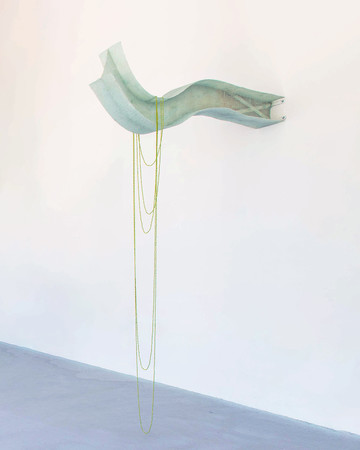In her practice, Salazar Rosales focuses on the lives, origins and functions of materials, many of which highlight the contrast between local architecture, typical of a place that uses materials and structures consistent with the space in which they are.
In this series, the artist has represented a bent IPN beam, or the structural element most commonly used in civil construction in order for a building to withstand the heavy weight it must carry. Typically made from steel, the reimagined beams of Salazar Rosales are constructed using fine, white-blue glass fixed onto fiberglass. Bent into irregular positions, these industrial structures (without which we could not safely inhabit many interior spaces) are shown to be fatigued by the burden they are destined to resist. The artist explains, “I imagined that they were fragile and uncared for and since they are hidden we cannot see how they are.” By removing them from their urban origins, Salazar Rosales offers an empathetic contemplation of their emotive condition. The title, When the axial skeleton decides to speak, thus poetically treats the sculpture more like a body by referring to it as a skeleton.
“This work also carries with it an Orula necklace, a handcrafted necklace used by practitioners of the Yoruba religion in Cuba. Recurring in her practice, these beaded charms represent small moments or gestures of protection, contextualizing Salazar Rosales’s works in an environment of affection and love.”*
This piece has the Orula necklace and the other has an Ojo de Buey seed. With the necklace resting on the upper half of this work, the sculpture seems to be bending due to the seed, which is itself a symbol or a place of origin, included within the necklace but also protection
*Quote from Spanish: “Gestos de construcción verbalizados en arte. Una conversación con Sofia Salazar Rosales.” By Dayneris Brito

